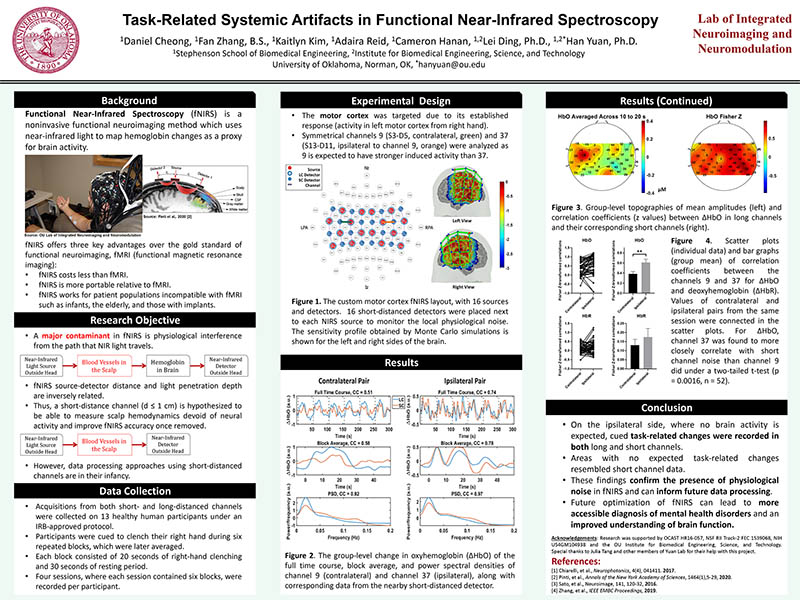
Hover to pan and click to magnify. Click again to pan at full screen.
Daniel A. Cheong, F. Zhang, K. Kim, A. Reid, C. Hanan, L. Ding and H. Yuan, Dept. of Biomedical Engineering, University of Oklahoma, Norman, OK. Faculty Advisor, Dr. Han Yuan, University of Oklahoma, Norman, OK.
Daniel A. Cheong, F. Zhang, K. Kim, A. Reid, C. Hanan, L. Ding and H. Yuan, Dept. of Biomedical Engineering, University of Oklahoma, Norman, OK. Faculty Advisor, Dr. Han Yuan, University of Oklahoma, Norman, OK.
ABSTRACT
Introduction: Functional Near-Infrared Spectroscopy (fNIRS) is a neuroimaging technique that emits near-infrared light into the scalp and measures the light absorbed in the brain. It is relatively low-cost, portable, and noninvasive compared to other neuroimaging methods, such as functional magnetic resonance imaging (fMRI). However, data processing methods to improve fNIRS signals are still in their infancy.
Objective: One promising development in fNIRS data processing is through implementing short channel regression into conventional fNIRS. Short channel regression utilizes special channels of short source-detector separation in which the recorded signals originate from light that mainly penetrates the scalp. Thus, these short channels theoretically capture a physiological signal devoid of brain activity, which can be removed from long channel activity to improve the overall accuracy of fNIRS. This study is an investigational study of short channel activity during fNIRS neuroimaging.
Methods: We used short channel fNIRS on thirteen healthy human participants during a right-hand clenching task to monitor motor cortex activity. Data was processed in MATLAB with the Homer2 toolbox and custom-built scripts.
Results: Across all sessions, the channel with the highest mean ΔHbO was identified as Channel 9. Channel 9 and its symmetrical channel (Channel 37) were used for further analysis.* After comparing Channel 9 with its ipsilateral counterpart (Channel 37), we found a significant difference between the correlation of that channel’s signal over time with that of its closest short channel compared to the same correlation on the ipsilateral side.* (*Refer to poster for figures related to these results.)
Conclusion: On the ipsilateral side, where no brain activity is expected, task-related changes were recorded in both long and short channels. These findings confirm the presence of physiological noise in fNIRS and also indicates the necessity for global signal removal to improve fNIRS accuracy.
Relevance: Overall, this study provides a guide for future studies using fNIRS and short channel regression in removing physiological noises. These results can help optimize how further brain studies should be conducted and facilitate our understanding of human brain function, leading to potential breakthroughs in treating mental disorders.

DISQUS COMMENTS WILL BE SHOWN ONLY WHEN YOUR SITE IS ONLINE